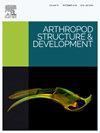甲虫超科甲虫总科中直肠复合体独立进化的证据。
IF 1.3
3区 农林科学
Q2 ENTOMOLOGY
引用次数: 0
摘要
直肠或隐肾复合体在节肢动物中反复进化,包括在Cucujiformia + Bostrichoidea的~ 190,000种甲虫中出现,以及鳞翅目的~ 160,000种中出现。马氏小管/肾小管的部分覆盖在直肠的外表面,作为肠道内容物的强大循环系统,回收水和特定溶质。有迹象表明,直肠复合体是在另一种甲虫群——圣甲虫科中独立进化出来的。在这里,我们报告我们的观察直肠复合体在金龟子,这支持这一观点。我们没有发现直肠复合体在相关组,葡萄球菌总科,或在Lucanidae,金龟子总科的基础组。我们确实观察到了Melolontha Melolontha (Melolonthini), Pachnoda marginata和Cetonia aurata (cetoniae)的直肠复合物,与这些群体的先前报道一致。有趣的是,我们发现直肠复合体出现在成虫身上,而没有出现在melolontha幼虫身上,而在蜜蜂科幼虫身上没有出现,这表明这些器官系统在蛹中发生了戏剧性的重塑。对Scarabaeoidea的直肠复合体的结构的见解与Cucujiformia的直肠复合体进行了比较。最后,我们讨论了甲虫直肠复合体在金龟子总科中的可能功能,以及未来解决这个问题的方法。本文章由计算机程序翻译,如有差异,请以英文原文为准。
Evidence for the independent evolution of a rectal complex within the beetle superfamily Scarabaeoidea
Rectal or cryptonephridial complexes have evolved repeatedly in arthropods, including in beetles where they occur in ∼190,000 species of Cucujiformia + Bostrichoidea, and Lepidoptera where they occur in ∼160,000 species. Sections of the Malpighian/renal tubules coat the outer surface of the rectum, acting as powerful recycling systems of the gut contents, recovering water and specific solutes. There are hints that a rectal complex evolved independently within another beetle group, Scarabaeoidea. Here we report our observations of rectal complexes in Scarabaeoidea, which support this view. We did not find a rectal complex in the related group, Staphylinoidea, or in Lucanidae, a basal group of Scarabaeoidea. We did observe rectal complexes in Melolontha melolontha (Melolonthini), Pachnoda marginata and Cetonia aurata (Cetoniinae), consistent with previous reports from these groups. Intriguingly we found that rectal complexes occur in adult, but not M. melolontha larvae, and larvae but not adults within Cetoniinae, indicating dramatic pupal remodelling of these organ systems. Insights into the structure of the rectal complexes of Scarabaeoidea are compared with the well-studied rectal complexes of Cucujiformia. Finally, we discuss possible functions of the rectal complexes of beetles within Scarabaeoidea, and future approaches to address this question.
求助全文
通过发布文献求助,成功后即可免费获取论文全文。
去求助
来源期刊
CiteScore
3.50
自引率
10.00%
发文量
54
审稿时长
60 days
期刊介绍:
Arthropod Structure & Development is a Journal of Arthropod Structural Biology, Development, and Functional Morphology; it considers manuscripts that deal with micro- and neuroanatomy, development, biomechanics, organogenesis in particular under comparative and evolutionary aspects but not merely taxonomic papers. The aim of the journal is to publish papers in the areas of functional and comparative anatomy and development, with an emphasis on the role of cellular organization in organ function. The journal will also publish papers on organogenisis, embryonic and postembryonic development, and organ or tissue regeneration and repair. Manuscripts dealing with comparative and evolutionary aspects of microanatomy and development are encouraged.

 求助内容:
求助内容: 应助结果提醒方式:
应助结果提醒方式:


